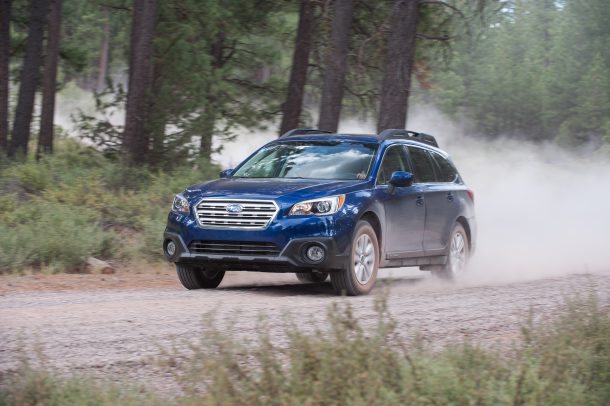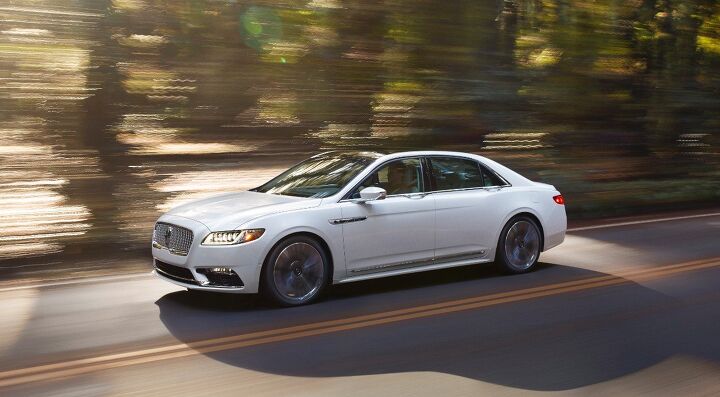Subaru Outback Outsells Most Of The Volkswagen Brand In September, Most Minis Are Big, Viper And NSX Tie, BMW Fades, And More September Sales Stats
At the beginning of each and every month, automakers release complete U.S. sales results for nearly every make and model. Sometimes the numbers are spectacular. Other times, surprising. Sometimes they’re just downright silly; nonsensical even. More often than not, the interesting tidbits are subtle.
Spectacular, surprising, silly, and subtle they may be, but not all such data points are worthy of a story. So we’ve plucked out a handful of results and statistics that are worthy of some attention from September 2016, a month in which new vehicle sales slid slightly less than 1 percent.
Ford sells a lot of F-Series pickups, the Toyota Camry is still America’s best-selling car, Americans are buying more SUVs/crossovers than cars. But auto sales figures are more interesting behind the headlines.
10: September was the tenth consecutive month in which U.S. sales at the BMW brand decreased on a year-over-year basis. September volume was down 5 percent. Year-to-date, the BMW brand’s 8-percent drop was caused by an 18-percent decrease in car sales. The brand’s five X models are up 12 percent.
33%: High-end luxury SUVs are supposed to instantly become top sellers, or so the story went at Jaguar and Bentley. At Maserati, it’s taking slightly longer for the Levante to ramp up. One-third of the Maseratis sold in the U.S. in September were Levantes, the second month it’s been on sale. The Ghibli remains the brand’s best-selling model — up to this point.
30: Not since the Lincoln MKS earned 1,034 sales in March 2014, 30 months ago, have sales of full-size Lincoln sedans risen as high as they did in September 2016. Thank the arrival of the new Continental, the MKS’s replacement. Together, the MKS’s 239 sales and the Continental’s first-month total of 775 units — expected to rise quickly — represented a 102-percent year-over-year increase over the MKS’s September 2015 total.
$4,590: Launched together in May, the Jaguar F-Pace crossover was consistently more popular than Jaguar XE sedan, which costs $4,590 less than the F-Pace, the next least-costly Jag. As XE inventory has improved, however, sales have improved in step. In September, the XE outsold the F-Pace by 20 units, 829 to 809, to become Jaguar USA’s best seller for the first time. Together, the two models accounted for six in ten Jaguar sales in September.
-188: Sales of the Mazda MX-5 Miata, now many months into its fourth-generation tenure, have been falling ever since its Fiat 124 Spider twin arrived. In September, MX-5 sales fell by a fifth, a loss of 188 sales. But total MX-5/124 Spider sales jumped 32 percent thanks to 490 additional 124 Spider sales.
7,297: With sales of other Buicks up 7 percent, in large part because of a clear-out of discontinued Veranos (sales of the Verano jumped 65 percent), Buick’s best-selling Encore reported an all-time monthly record of 7,297 sales, a year-over-year jump of 30 percent. More than half of the Buicks sold in the United States in September were Encores and Veranos.
71%: Mini USA reported 4,024 total sales in September, a 9-percent year-over-year drop. 71 percent of those sales, or 2,877 units, were produced by Minis with four doors: the 4-Door, Clubman, and Countryman. Of the 38,911 Minis sold so far this year in the United States, 26,994 were of the maxi Mini variety.
28,172: Fully 11.3 percent of the new vehicle sales reported by General Motors in September 2016 were of the full-size SUV variety. Total volume of the Escalade, Escalade ESV, Suburban, Tahoe, Yukon, and Yukon XL jumped 45 percent to 28,172 units. A year ago, the same group earned 7.7 percent of GM’s sales.
38: Nearing the end of its lifecycle, Fiat Chrysler Automobiles reported 38 Dodge Viper sales in September 2016. Only a few months into the beginning of its lifecycle after a decade-long hiatus, the Acura NSX likewise found 38 new owners.
3,699: In the odd race to end 2016 as America’s top-selling premium marque — exclusivity is clearly not king — Mercedes-Benz outsold Lexus by 3,699 units in September. ( Sprinter and Metris vans are excluded.) Year-to-date, Mercedes-Benz leads Lexus by 13,011 units and BMW by 19,071.
+14: U.S. sales of the Mitsubishi i-MiEV increased by 14 units, year-over-year, in September 2016, to 17 in total. Although total Mitsubishi sales are ahead of last year’s pace by 1.5 percent in September, every Mitsubishi except the i-MiEV posted year-over-year declines.
2,484: For the Nissan Titan, now finally available in both XD and light-duty form, September’s 2,484 sales represented the best month for Nissan’s full-size truck since September 2008. 1.3 percent of the full-size trucks sold in America in September 2016 were Titans.
711: Toyota reported 386 sales of the Lexus LX570 in September along with 325 sales of the LX’s Toyota Land Cruiser twin, for a total of 711 September sales. Sales of both SUVs have boomed relative to past performance because of MY2016 refreshes. The Land Cruiser is on track for its best year since 2008; the LX is on track for its best year since 2012.
-24%: U.S. sales at the Porsche brand tumbled 24 percent in September 2016 — that is if you don’t count the Macan. But the Macan, now the brand’s best-selling model, jumped 72 percent to 1,998 units, causing the Porsche brand — despite decreases at every other model — to rise 1.2 percent.
131: Overpriced and undersized relative to its prime competitor, the Subaru Outback, the Volkswagen Alltrack reported its first 131 sales in September. Don’t ever expect the Alltrack to approach Outback-like sales figures. Subaru sold 16,978 Outbacks in September, more than the Beetle, CC, Passat, Tiguan, Touareg, and entire Golf family combined.
Timothy Cain is the founder of GoodCarBadCar.net, which obsesses over the free and frequent publication of U.S. and Canadian auto sales figures. Follow on Twitter @goodcarbadcar and on Facebook.
More by Timothy Cain
Latest Car Reviews
Read moreLatest Product Reviews
Read moreRecent Comments
- Redapple2 Love the wheels
- Redapple2 Good luck to them. They used to make great cars. 510. 240Z, Sentra SE-R. Maxima. Frontier.
- Joe65688619 Under Ghosn they went through the same short-term bottom-line thinking that GM did in the 80s/90s, and they have not recovered say, to their heyday in the 50s and 60s in terms of market share and innovation. Poor design decisions (a CVT in their front-wheel drive "4-Door Sports Car", model overlap in a poorly performing segment (they never needed the Altima AND the Maxima...what they needed was one vehicle with different drivetrain, including hybrid, to compete with the Accord/Camry, and decontenting their vehicles: My 2012 QX56 (I know, not a Nissan, but the same holds for the Armada) had power rear windows in the cargo area that could vent, a glass hatch on the back door that could be opened separate from the whole liftgate (in such a tall vehicle, kinda essential if you have it in a garage and want to load the trunk without having to open the garage door to make room for the lift gate), a nice driver's side folding armrest, and a few other quality-of-life details absent from my 2018 QX80. In a competitive market this attention to detai is can be the differentiator that sell cars. Now they are caught in the middle of the market, competing more with Hyundai and Kia and selling discounted vehicles near the same price points, but losing money on them. They invested also invested a lot in niche platforms. The Leaf was one of the first full EVs, but never really evolved. They misjudged the market - luxury EVs are selling, small budget models not so much. Variable compression engines offering little in terms of real-world power or tech, let a lot of complexity that is leading to higher failure rates. Aside from the Z and GT-R (low volume models), not much forced induction (whether your a fan or not, look at what Honda did with the CR-V and Acura RDX - same chassis, slap a turbo on it, make it nicer inside, and now you can sell it as a semi-premium brand with higher markup). That said, I do believe they retain the technical and engineering capability to do far better. About time management realized they need to make smarter investments and understand their markets better.
- Kwik_Shift_Pro4X Off-road fluff on vehicles that should not be off road needs to die.
- Kwik_Shift_Pro4X Saw this posted on social media; “Just bought a 2023 Tundra with the 14" screen. Let my son borrow it for the afternoon, he connected his phone to listen to his iTunes.The next day my insurance company raised my rates and added my son to my policy. The email said that a private company showed that my son drove the vehicle. He already had his own vehicle that he was insuring.My insurance company demanded he give all his insurance info and some private info for proof. He declined for privacy reasons and my insurance cancelled my policy.These new vehicles with their tech are on condition that we give up our privacy to enter their world. It's not worth it people.”





































Comments
Join the conversation
Honestly, I'm surprised that anyone buys Outbacks, let alone enough for them to dent VW. It looked that the only interesting Subaru cars recently were Forester and XV (Crosstrek).
The VW Sportwagen is a much better car than the Outback by any measure. The Sportwagen has not even been officially released! I would bet it would even show the 3.6 a clean pair of heels in straight-line performance. I have driven an Outback 3.6 - it's basically outdated rubbish. My personal experience ( and that of 3 friends) is that Subarus are not that reliable. I blew two head gaskets at 80K ( 2005 Legacy GT), and my friends Impreza (non turbo) has started leaking so much oil at 120K that it's almost a write-off. And that Outback 3.6 is pretty much hated by the owners who are looking for an excuse to dump it and it's miserable whiney 5 speed auto transmission. Subaru global sales 940K VW global sales ~10M